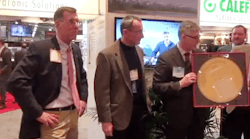In addition to the expansive AHR trade show halls, an education track with a wide array of presenters can greatly enhance the value of attending the show while expanding your knowledge. Doing so can separate you from your competition back home, provide you with a reputation for outstanding performance, and command higher profits.
In 1998 Gary Hayden, an engineer with Burnham Boilers, posted a hypothetical question on an internet site about installing air conditioning for a radiantly heated slab-on-grade addition with no attic for concealing ductwork. I answered and he contacted me and asked if I would submit a bid. After the installation, Hayden suggested I should join the RPA (Radiant Panel Association) and submit the installation for the RPA’s annual Showcase Awards. Thinking the whole thing a waste of time, I resisted, but if you know Hayden, you know he does not give up. I joined in order to get some peace and quiet, but that only egged Hayden on to insist I submit the installation and attend the 2000 RPA convention in Providence, RI. I’ll reveal how our installation fared in the juried contest later – read on!
Richard Trethewey, the plumber from This Old House was the keynote speaker and we (my wife Lois attended the show with me) thought it would be cool to meet Trethewey as we often watched the show and looked forward to his promotion of radiant heating. Lois and I had, prior to attending the RPA convention, selected education tracks and first up for me was a class on hydronics by John Siegenthaler. Entering the room, I was confident my hydronic knowledge was pretty solid, but just a few minutes after Siggy, as he likes to be called, began speaking, while PowerPoint slides with formulas were displayed, I quickly realized my depth of hydronic knowledge was not that great. As the years went by, I took every class Siggy taught and became certified for Installation, Design, and Instructor in all things hydronic.
In 2011, I became a reformed circaholic and began promoting and selling ECM circulators in conjunction with low-watt zone valves.
While attending AHR 2019 in Atlanta, GA, Siggy was teaching Distribution Efficiency – The Often Overlooked Advantage of Hydronics Technology for the RPA (now Radiant Professionals Alliance). Course description: This session defines the concept of distribution efficiency. It then compares the distribution efficiency of properly designed and poorly designed hydronic systems to that of forced air and VRF systems. It shows how to create state of the art hydronic systems that maximize distribution efficiency, and how to estimate their diminutive operating cost. If you design hydronic heating or cooling systems you need to understand and apply the concept of distribution efficiency in both design and marketing.
Siggy illustrated a number of hydronic installations featuring banks of induction-motor circulators lined up like soldiers at attention. “Good craftsmanship, wrong approach,” and thus began the details on Btuh/watts to determine the often overlooked parasitic energy consumption of using large numbers of 87-watt circulators instead of just one or two low-wattage ECM circulators in conjunction with 1- or 3-watt zone valves.
I’d had my own epiphany in 2003 while attending the ISH convention in Frankfurt, Germany when I encountered a large display of low-wattage ECM circulators using a fraction of our USA available circulators. Like the slides Siggy was showing, I too was a circaholic quite pleased to be installing hydronic systems with multiple circulators – like the one in my own home with its 13-circulators. When ECM circulators finally became available in the USA, I revised my home’s system to two ECM circulators and ten 3-watt zone valves. My annual cost for delivering comfort energy dropped from $375.05 to $24.83! Fast forward to 2019 and I’ve reduced our energy consumption by more than $6,800.00. In 2011, I became a reformed circaholic and began promoting and selling ECM circulators in conjunction with low-watt zone valves and sold those systems based upon not just modcon high-efficiency boilers, but with emphasis on the electrical efficiency side of the equation. Once presented to owners, the added cost was in their own best interest and we consistently won bids that were higher than our competition. Siggy turned to me and asked “Dave, you’re a recovering circaholic, right?” Hah! Guilty as charged, but “reformed” actually fits better.
Siggy went on to illustrate why a hydronic system can be up to 400 percent more efficient than air-based heating systems when properly designed and backed that up with lots of detailed calculations.
Siggy’s Design guidelines for achieving high distribution efficiency:
· Use valve-based zoning
· Use high efficiency (ECM) circulators
· Use parallel distribution systems
· Use “short/fat” headers
· Use low head loss heat sources
· Use high delta-T to reduce flow requirements
· Evaluate life-cycle cost of using one size larger piping
It was refreshing to spend time in Siggy’s well-attended class.
Siggy’s summary:
1. High distribution efficiency is a distinct benefit of well-planned hydronic heating and cooling systems.
2. High distribution efficiency is also a very underutilized concept when comparing hydronic systems to alternatives.
3. Don't just promote thermal efficiency of heat sources.
4. Promote the superior distribution of hydronics to “energy conscious” people. They will listen.
5. Use the simple formula (design load / watts) to assess the distribution efficiency of your systems.
6. If I’m ever a judge for a contest on superior hydronic systems and you send in an entry with 34 high efficiency circulators along a wall, don’t expect my vote!
As for the 2000 RPA contest, we won an award for that radiant installation, and, thanks to the ongoing training via the RPA, we won additional awards including Best of Show in the following years. As an ASSE 19210 certified instructor, I look forward to passing along what I’ve learned in the years to come. I highly recommend obtaining a copy of John Siegenthaler’s Modern Hydronic Heating, which is a required textbook for taking the RPA’s ASSE 19210 hydronic heating and cooling course.
Dave Yates material both in print and online is protected by Copyright 2018. Any reuse of this material (print or electronic) must have the express written permission of Dave Yates and CONTRACTOR magazine. Please contact via email at [email protected].


